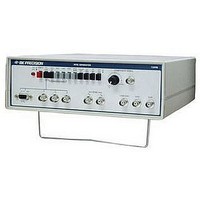1249B B&K Precision, 1249B Datasheet - Page 15

1249B
Manufacturer Part Number
1249B
Description
COLOR GENERATORNTSC/RGB
Manufacturer
B&K Precision
Type
NTSC Benchtopr
Specifications of 1249B
Patterns
Bar, Dot, Crosshatch, Raster
Connection Method
RCA, RF, S-Video
Power Source
105,130VAC
Signal Generator Type
NTSC Pattern
Supply Voltage Range
105V To 130V
External Height
86mm
External Width
290mm
External Depth
264mm
Frequency
30 Hz
Equipment Type
NTSC Pattern Generators
Lead Free Status / RoHS Status
na
Lead Free Status / RoHS Status
na
Other names
BK1249B
white.
shadings of grey. Even when a composite video signal is not at the
1 volt peak-to-peak level, the ratio between the sync pulse and
video must be maintained. 0.3 of total for sync pulse and 0.7 of
total for 100% white.
There is also a specific relationship between the amplitude of the
composite video signal and the percentage of modulation of an rf
carrier. A television signal uses negative modulation, wherein the
sync pulses (-40 units) produce the maximum peak-to-peak
amplitude of the modulation envelope (100% modulation) and
white video (+100 units) produces the minimum amplitude of the
modulation envelope (12-1/2% modulation). This is very
advantageous because the weakest signal condition, where noise
interference can most easily cause snow, is also the white portion
of the video. There is adequate amplitude guard band so that peak
white of +100 units does not reduce the modulation envelope to
zero.
COLOR
(Refer to Fig. 3)
The color information is a composite video signal consists of
three elements: luminance, hue, and saturation.
Luminance, or brightness perceived by the eye, is represented by
the amplitude of the video signal. The luminance component of a
color signal is also used in monochrome receivers, which is
converted to a shade of grey. Yellow is a bright color and has a
high level of luminance (is nearer to white), while blue is a dark
color and has a low level of luminance (is nearer to black).
THE NTSC COLOR VIDEO SIGNAL (CONT.)
Levels between +7.5 and +100 units produce various
15
green. etc. White, black and grey are not hues. The phase angle of
the 3.58MHz color subcarrier determines the hue. The three
primary video colors of red, blue, and green can be combined in
such a manner to create any hue. A phase shift of 360° will produce
every hue in the rainbow by changing the combination of red,
blue, and green.
amount the color is diluted by white light. Saturation is often
expressed in percent: 100% saturation is a hue with no white
dilution which will produce a very vivid shade. Low saturation
percentages are highly diluted by white light and produce light
pastel shades of the same hue. Saturation information is contained
in the amplitude of the 3.58MHz color subcarrier. Because the
response of the human eye is not constant from hue to hue, the
amplitude required for 100% saturation is not the same for all
colors.
chrominance. This information is normally represented by a
vector diagram. Saturation is indicated by the length of the vector
and hue is indicated by the phase angle of the vector. The entire
color signal representation is three dimensional, consisting of the
vector diagram for chrominance and a perpendicular plane to
represent the amplitude of luminance.
NTSC COLOR BARS SIGNAL
amplitude required for 100% saturation of some hues is
considerably greater than for other hues. Also, the luminance level
for each color differs. The NTSC color bars signal generates
standard EIA colors at the prescribed luminance level
(brightness), chroma phase angle (hue), and chroma amplitude
Hue is the element that distinguishes between colors, red, blue,
Saturation is the vividness of a hue, which is determined by the
The combination of hue and saturation is known as chroma, or
Refer again to Fig. 1. As mentioned previously, the chroma










